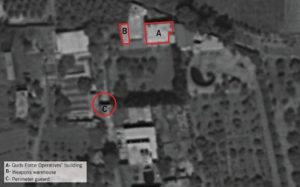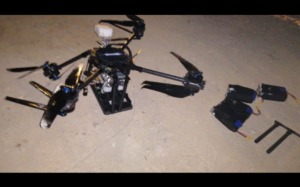FACT SHEETS
RESOURCES
Fast Facts: Alleged Israeli attacks on Iranian-linked targets over recent days
August 28, 2019 | AIJAC staff

Over the last few days, there have been four attacks against sites in Syria, Lebanon, and Iraq which have been attributed to Israeli forces.
While it is not clear that all of the attacks are in fact Israeli (though Israel has taken responsibility for the attack in Syria near Damascus) Australian observers should understand the following basic facts and context about the attacks:
- The Israeli attacks should be understood as part of the wider “conflict between the wars” with Iran designed to prevent the build-up of permanent large-scale Iranian forces and bases in Syria, and more recently, also in Iraq. As IDF Maj. Gen (ret.) Yaakov Amdiror, former head of Israel’s National Security Council told a journalist, “We are trying to prevent Iran from building an Iranian war machine in Syria. Everything else is a result of this effort.”
- The attack near Damascus appears to have been an attempt to pre-empt an imminent attack by Iran and its proxies on Israel from a drone base, and the same may be true of the attack on a camp in Lebanon’s Bekaa Valley.
- The material released after the attacks by Israel appear to demonstrate stunning Israeli intelligence achievements in detailed tracking of the movements, preparations, and intentions of Iranian and proxy forces.
- There are serious concerns that the recent attacks could lead to a major escalation, with Iranian proxy Hezbollah making unusually direct threats, and Israeli PM Binyamin Netanyahu taking the unusual step of arranging for a security briefing for Opposition Leader Benny Gantz about the situation, suggesting major concerns in Jerusalem.
- Israeli Finance Minister Moshe Kahlon has said of the recent attacks, “there are also things being attributed to us that aren’t ours.”
Here is a summary of what is known about the four attacks in question:
Sunday, August 25 – Israel hits a base at Aqrabe in Syria to prevent attempt to launch a drone attack on Israel from Syria
- An Iranian Revolutionary Guards Corps (IRGC) squad was spotted on Thursday, August 22, preparing to launch suicide drones carrying explosive charges from the village of Aqrabe, south of Damascus, against targets in northern Israel
- The drones had been delivered a few weeks earlier from Iran through Damascus, together with Iranian experts to assist with the operation.
- Javad Jafari, the commander of the Iranian forces in Syria including Shiite fighters from Iran and other countries, was in charge of the squad. Jafari is a senior IRGC Quds Force officer, under the command of Qassem Soleimani, who personally directed the operation.

Iranian commander of the mission Gen. Javad Jafari is a senior IRGC Quds Force officer, under the command of Qassem Soleimani.
- On Thursday, August 22, the unit attempted to carry out the attack from at the village of Arane, a location close to the Syrian border with the Israeli controlled Golan Heights at the village of Arane.
- IDF foiled the attempt at Arane. A few days later, on Sunday Israeli airplanes destroyed the Aqrabe compound from which the attack was organised.

The squad’s Aqrane compound.
- The drone squad was comprised of two Lebanese Shi’ites with links to Hezbollah and two Iranians. The Lebanese militants from the squad killed in the Israeli attack were Hasan Yousif Zbib and Yasir Ahmad Dahir.

Squad members Hasan Yousif Zbib and Yasir Ahmad Dahir board a plan to Iran to train, in photos released by the IDF.
Israel has released pictures of the two boarding the Iranian airline Mahan Air in one of their flights to Iran for drone operation training.
- Israel has taken responsibility for this attack, with Israeli PM Netanyahu announcing:
“In a complicated operation by the security establishment, we revealed that Iran’s Quds Force dispatched a special unit of Shi’ite militants to Syria in order to kill Israelis on the Golan Heights with explosives-laden UAVs.
“I would like to emphasize: This was an initiative of Iran, under the command of Iran, at the behest of Iran.
“In a daring decision, and in a perfect IDF operational and intelligence effort, we pre-empted them and thwarted this attack; we prevented serious attacks. Henceforth we will expose any attempt by Iran to attack us and any Iranian effort to hide behind this or that excuse.
“I would like to stress that we will not tolerate aggression against Israel from any country in the region.”
Sunday, August 25 – Alleged suicide drone attack in Beirut
- Two commercial DJI UAVs crashed on Sunday night (August 25) in the heart of Hezbollah’s famous stronghold, in the Moawwad neighbourhood in Beirut’s Dahiyeh quarter.
- According to the Lebanese media, one of the drones was shot down by stones thrown at it by youngsters. The other one entered the scene 45 minutes later, exploded mid-air and crashed on the roof of a building where Hezbollah’s media offices are located. Three people were wounded.
- According to Hezbollah, both drones were loaded with 5.5 kg of C4 explosive.
- Videos on social media that cannot be verified for their authenticity, allegedly documenting the incident, either show one drone soaring above a parking lot, and/or two trucks burning after an explosion.
- These small drones have a short flight range, force their operators to be close by (just a few km away), can only stay in the air around 20 minutes carrying a small load. In other words, they could not have been flown to Beirut from Israel.
- Some experts suggest the drones do not appear to be models Israel uses and appear Iranian made. Similar drones were used by ISIS militants in Iraq.
- No one claimed responsibility for the attack. Hezbollah is blaming Israel for the attack and has promised revenge.
- The British newspaper The Times claimed that the drones were Israeli and targetted and destroyed shipping containers attached to trucks with Iranian made “machinery to mix high-grade propellant” for missiles and the computerised control mechanism for the equipment that was in a separate crate. This sophisticated machine was flown in from Iran to be used in Hezbollah’s precision guided missile project, flagged by Israel as an unacceptable strategic threat.
- This Iranian-organised project is meant to upgrade the huge stock of at least 130,000 short range (5-500km) ‘simple’ rockets of various types held by Hezbollah (and by other Shi’ite terror groups in Iraq and Syria). To achieve this aim, GPS guidance systems are being fitted onto ‘dumb’ missiles in factories in Lebanon.
- Israeli media reports quoted experts saying that, if the Times story was accurate, the destruction of the alleged rare machinery would have significantly set back Hezbollah’s precision guided missile project, adding a delay of at least a year.

Alleged photo of one of the destroyed drones from Lebanese media.
Monday, August 26 – Strike on a PFLP base near the Lebanese border
- Arab media claimed that Israeli warplanes attacked (August 26) a base in Lebanon of the Popular Front for the Liberation of Palestine – General Command (PFLP-GC), under Ahmed Jibril – a terrorist organisation aligned with Hezbollah.
- The site targeted is located at Qousaya, at the Bekaa Valley, next to the border with Syria.
- Jerusalem has not confirmed that it was an Israeli attack. However, if it is the case, then this would have been the first time Israel has launched strikes in Lebanon since the end of the Second Lebanon War in 2006.
- An unnamed Israeli defence official hinted that the strike was carried out based on intelligence of an expected retaliatory attack from Lebanon. He was quoted as saying “If the IAF had, in fact, carried out the strike, it would have been to prevent retaliation by Hezbollah over Sunday’s operation.”
- Following the developments in Lebanon, diplomacy was put in motion. Responding to declarations by Lebanon’s President Michel Aoun that the various attacks can be constituted as an act of war, US Secretary of State Mike Pompeo conveyed a message to the Lebanese Government urging restraint and de-escalation.
August 25 – UAV raid in Iraq on a Shi’ite militia aligned with Iran
- A convoy of the Popular Mobilisation Forces (PMF), the state-backed militia group that has fought ISIS at the Iraqi-Syrian border for several years, was attacked on Sunday, August 25, by a UAV in Anbar province in Iraq.
- Several people were killed. According to Arab social media sources, top PMF commander Abu Ali Aldebai was killed in the attack when a missile struck his car near al-Qa’i, close to the Iraqi-Syrian border. Aldebai may have been involved in missile convoys and or storage for the organisation.
- Israel was blamed for the attack but has not taken responsibility for it. In recent months, there were multiple reports about alleged Israeli activity against missile depots in Iraq belonging to militias aligned with Iran, and Israeli PM Benjamin Netanyahu has hinted (August 22) that Israel was responsible. PMF related sources said that the organisation has been attacked at least 13 times during the last year.

The funeral of PMF commander Abu Ali Aldebai.





